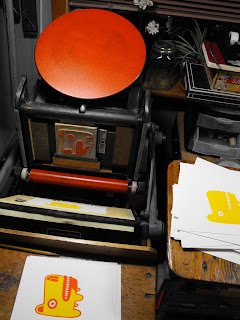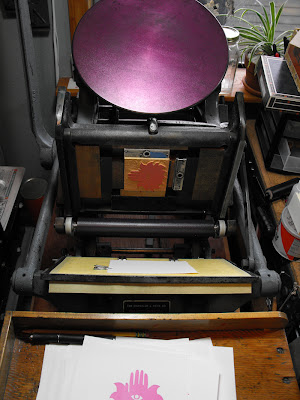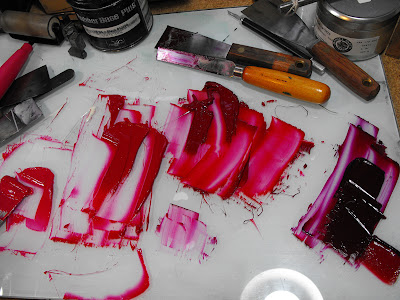I am using a networked drive, an external backup and a weekly hard backup now. Lesson learned. I still am not using hierarchic folder structures as often as I should but, I'm getting better...
Tuesday, November 29, 2011
Finished the reduction cut I started a couple days ago. Turned out okay, my hands are getting a little more steady. I have another cut started but, didn't get to print the first color yet.
I got into the weeds in the afternoon doing some paperwork, phone call stuff and organization of my photograph archive that's been a mess for a year or so since I switched primary computers after a power supply failure.
I am using a networked drive, an external backup and a weekly hard backup now. Lesson learned. I still am not using hierarchic folder structures as often as I should but, I'm getting better...
I am using a networked drive, an external backup and a weekly hard backup now. Lesson learned. I still am not using hierarchic folder structures as often as I should but, I'm getting better...
Saturday, November 26, 2011
Worked on a new reduction cut today. I have been imagining these creatures for a while so, it was cool to see one make it out into the world.
My tiny studio has seven color corrected 100w florescent lights blaring for the short Seattle winter days and long nights. It's getting pretty crowded, but it feels cozy and kinda crazy.
I'm surrounded floor to ceiling with paper, ink, tools, presses, artwork, photographs, & drying racks. Music is blaring it's a pretty great place to be.
I like using really bright color. I try to use inks with only transparent pigments and add transparent base often to keep the paper brightness coming through.
It keeps the colors alive and together as they layer, mixing to produce something new on the print.
I'm surrounded floor to ceiling with paper, ink, tools, presses, artwork, photographs, & drying racks. Music is blaring it's a pretty great place to be.
Friday, November 25, 2011
Paper on the brain!
I've been doing a head count in my paper library today and checking how it's doing. Paper ages and is susceptible to a wide range of environmental damage in storage. Little critters like to eat the gelatin sized stuff too. I do an inspection and inventory every couple months.It also helps generate ideas and reminds me what's lurking in the dark corners.
I don't have my own paper cutter, which is okay. I don't have room for one of any useful size really and the small ones are difficult to come by anyway. I have been a teaching assistant at the School of Visual Concepts for quite a while and they have a wonderful 23" cutter I can use.
I cut down full sheets to a number of fixed sizes that I've found comfortable to work in on my printing presses and keep them on hand. I don't run out too often, there is always new paper coming in.
My paper collection may be a manifestation of some latent hoarding kink in my psychology. (My lovely wife has pointed this out gently on a number of occasions) Stacks of the cottony paper stuffs take up several storage areas of my home and the studio is packed with it. I use every part of a sheet of paper. I have found that even tiny off-cuts make for useful artwork. I usually even toss trimmings and scraps into a bag to be pulped into small hand-made sheets later.
I am picky about my paper and very 'use specific'. Ultimately, I'll print on anything I can find but, if I have choices or if it's artwork...I get heavily opinionated. I could fill volumes with rants about commercial paper and the sad state of the fine printmaking paper selection.
But, I won't. I'll just keep counting sheets and checking for paper nibbling critters and humidity damage.
I've been doing a head count in my paper library today and checking how it's doing. Paper ages and is susceptible to a wide range of environmental damage in storage. Little critters like to eat the gelatin sized stuff too. I do an inspection and inventory every couple months.It also helps generate ideas and reminds me what's lurking in the dark corners.
I don't have my own paper cutter, which is okay. I don't have room for one of any useful size really and the small ones are difficult to come by anyway. I have been a teaching assistant at the School of Visual Concepts for quite a while and they have a wonderful 23" cutter I can use.
I cut down full sheets to a number of fixed sizes that I've found comfortable to work in on my printing presses and keep them on hand. I don't run out too often, there is always new paper coming in.
My paper collection may be a manifestation of some latent hoarding kink in my psychology. (My lovely wife has pointed this out gently on a number of occasions) Stacks of the cottony paper stuffs take up several storage areas of my home and the studio is packed with it. I use every part of a sheet of paper. I have found that even tiny off-cuts make for useful artwork. I usually even toss trimmings and scraps into a bag to be pulped into small hand-made sheets later.
I am picky about my paper and very 'use specific'. Ultimately, I'll print on anything I can find but, if I have choices or if it's artwork...I get heavily opinionated. I could fill volumes with rants about commercial paper and the sad state of the fine printmaking paper selection.
But, I won't. I'll just keep counting sheets and checking for paper nibbling critters and humidity damage.
Tuesday, November 22, 2011
I have been distracted by errands, appointments and life in general the last few days, I haven't made it in the tiny room to print anything. I get a funny feeling like I've forgotten something important when I don't get a chance to make anything for a week or so. Uncomfortable.
I had to dig out my old work and do some packing. I haven't been keeping any records, organizing anything or even properly putting it up editions when I'm done. I found some damaged works and lost a few things.
I have a hard time with storing finished work. I always prepare some for selling or showing and the rest of the edition gets shoved into a flat file drawer.
It's the drawer shaped equivalent to that warehouse from the end of Raiders of the Lost Ark.
It's hard to clean it up too. I always get immediately distracted by old prints and start just looking at them and sometimes making new notes or drawings instead of efficiently wrapping them up and putting them away carefully.
On that note, I did find a tiny (2 x 2) dry point with chine colle series I totally forgot about.
I love drypoints, I usually do them on scraps of plexiglas. I use chine colle, usually silk tissue, single ply thai unryu or daphne for crisp line and to add some texture/interest. I have literally hundreds of plates and keep all my off cuts (and any others I can find in the bin) of good cotton paper.
It's a great brain massage to just draw out a few ideas, soak a little paper and run them through the press for a relaxing couple hours.
I have a hard time with storing finished work. I always prepare some for selling or showing and the rest of the edition gets shoved into a flat file drawer.
It's the drawer shaped equivalent to that warehouse from the end of Raiders of the Lost Ark.
It's hard to clean it up too. I always get immediately distracted by old prints and start just looking at them and sometimes making new notes or drawings instead of efficiently wrapping them up and putting them away carefully.
On that note, I did find a tiny (2 x 2) dry point with chine colle series I totally forgot about.
It's a great brain massage to just draw out a few ideas, soak a little paper and run them through the press for a relaxing couple hours.
Sunday, November 20, 2011
Started a new linoleum reduction print, its a seeing-eye-hand-bed-of-lotus thing. I only got the first layer printed before I had to stop for a couple days, hopefully the ink will still be permeable enough for the successive layers to turn out okay when I get back to the press.
The ink color is a mix of Quinacridone Red & Carbazole Violet in a large portion of Transparent Base. All are Lithography Inks made by Daniel Smith, the Carbazole Violet is no longer made unfortunately. Exceptionally good stuff. Strong color and if you keep them transparent they really glow, especially Quinacridone Red.
I like using lithography inks but, any good artist ink works really, you have to play with the ink body and most people throw up their hands after a while.
Anyway, it's looking good so far and I hope the later reductions go smoothly. Lots of chances to screw it up when cutting the same block over and over.
Saturday, November 19, 2011
I needed some new calling cards for my art making endeavors. I have the usual letterpress business card but, I wanted something more like a little art piece I could give out with my name and contact info on the back side.
I decided to print three reduction linoleum cuts in editions of 100 on some birch veneer laying around.
The real tricks are getting the pressure just right so it won't crush the wood fiber but yields a crisp image and soaking up some of the oil in the ink body with a reducer or some mag. carbonate powder (depending on the color).
The front side image cut in linoleum and printed in two colors went smoothly, it will be a couple of weeks before the back side can be printed with the info from handset metal type. The front needs to be totally dry so the pressure of printing the back won't cause offset or smearing. the type is ten times easier than linoleum is to print as the minuscule amounts of surface lead to easier control of ink and pressure.
I decided to print three reduction linoleum cuts in editions of 100 on some birch veneer laying around.
The real tricks are getting the pressure just right so it won't crush the wood fiber but yields a crisp image and soaking up some of the oil in the ink body with a reducer or some mag. carbonate powder (depending on the color).
The front side image cut in linoleum and printed in two colors went smoothly, it will be a couple of weeks before the back side can be printed with the info from handset metal type. The front needs to be totally dry so the pressure of printing the back won't cause offset or smearing. the type is ten times easier than linoleum is to print as the minuscule amounts of surface lead to easier control of ink and pressure.
Subscribe to:
Posts (Atom)
















